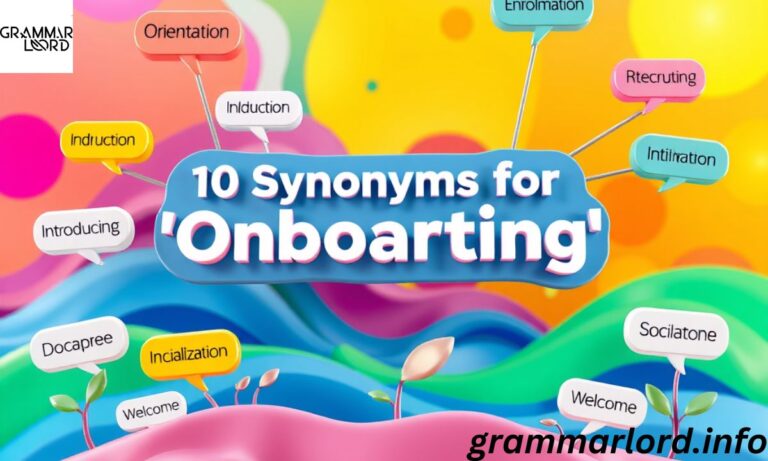The process of onboarding is critical for integrating new employees into an organization and ensuring they feel valued, informed, and prepared to contribute.
Below are alternative terms for “onboarding,” each highlighting different aspects of the process.
These synonyms emphasize the importance of cultural immersion, role clarity, and employee engagement in creating a supportive and productive work environment.
Employee Integration
Employee integration focuses on helping new hires transition smoothly into the organization’s culture and workflow.
This process ensures that employees feel aligned with the company’s values and mission while fostering a sense of belonging.
Key elements of effective employee integration include:
- Cultural Immersion: Helping new hires understand and embrace organizational values.
- Relationship Building: Encouraging connections with colleagues to create a supportive network.
- Skills Development: Providing opportunities for employees to enhance their abilities and contribute meaningfully.
- Feedback Mechanisms: Offering ongoing support and adjustments to improve the integration experience.
Mentorship programs can also play a vital role in guiding new employees through their roles and career paths, ensuring they feel empowered and engaged from day one.
Staff Induction
Staff induction serves as the foundation for a new hire’s journey within an organization. It introduces employees to the company’s values, mission, and expectations, ensuring they feel welcomed and supported from the start.
Key components of staff induction include:
- Essential Resources: Providing access to training materials, policies, and introductions to key team members.
- Open Communication: Encouraging new hires to ask questions and voice concerns.
- Inclusivity: Creating an environment that promotes personal and professional growth.
A well-structured induction program not only enhances the employee experience but also strengthens retention and productivity, contributing to a thriving workplace culture.
New Hire Orientation
New hire orientation builds on the foundation laid during staff induction by offering a structured overview of workplace policies, mentorship opportunities, and team dynamics. This phase ensures that new employees feel confident in their roles and responsibilities.
Key aspects of new hire orientation include:
- Performance Expectations: Clearly outlining responsibilities and goals.
- Mentorship Opportunities: Connecting new hires with experienced colleagues for guidance.
- Feedback Mechanisms: Establishing open communication channels for questions and suggestions.
- Workplace Diversity: Fostering an inclusive environment where all voices are heard and valued.
Orientation plays a crucial role in helping employees understand how they fit into the larger organizational structure, enhancing their sense of belonging and purpose.
Workforce Assimilation

Workforce assimilation emphasizes integrating new employees into the organizational ecosystem to ensure role clarity and support. This process fosters collaboration, camaraderie, and a cohesive workplace culture.
Key strategies for workforce assimilation include:
- Mentorship Programs: Guiding to help employees navigate their roles effectively.
- Role Clarity: Defining responsibilities to align individual efforts with organizational goals.
- Feedback Loops: Encouraging continuous improvement through constructive input.
- Career Pathways: Articulating clear paths for professional growth and development.
By prioritizing workforce assimilation, organizations empower employees to take ownership of their roles while contributing to the company’s overall success.
Talent Welcome
Creating a welcoming environment for new talent is essential for ensuring employees feel appreciated and engaged from the outset. A positive employee experience significantly contributes to talent retention and long-term success.
Effective talent welcome strategies include:
- Cultural Immersion: Aligning new hires with organizational values to foster a sense of belonging.
- Role Clarity: Ensuring employees understand their responsibilities and performance expectations.
- Peer Mentorship: Encouraging professional networking and workplace adaptability.
- Diversity Training: Promoting inclusivity and valuing varied perspectives.
Feedback mechanisms should also be established to encourage open communication and guide employees in their career progression.
Team Orientation
Team orientation focuses on integrating new employees into the workplace by fostering interpersonal relationships and role clarity. This process alleviates anxiety and encourages active participation in team dynamics.
Key elements of team orientation include:
- Team Bonding: Building connections among team members to enhance collaboration.
- Role Clarity: Clearly defining responsibilities to ensure employees understand their contributions.
- Open Communication: Encouraging questions and knowledge sharing to create a supportive atmosphere.
By prioritizing team orientation, organizations strengthen employee satisfaction, improve performance, and cultivate a collaborative work environment.
Resource Alignment
Resource alignment ensures that new employees have access to the tools and support they need to thrive in their roles. This process involves evaluating existing resources and allocating them effectively to meet individual needs.
Key strategies for resource alignment include:
- Training Materials: Providing comprehensive resources for skill development.
- Mentorship Programs: Offering guidance and support from experienced colleagues.
- Collaborative Platforms: Facilitating communication and teamwork among employees.
By investing in thoughtful resource coordination, organizations create an engaging and productive work environment, leading to higher employee satisfaction and retention.
Personnel Introduction
Introducing new personnel is a critical step in the onboarding process, setting the stage for successful team dynamics.
This phase ensures that employees understand their roles, responsibilities, and how they contribute to the organization’s mission.
Key aspects of personnel introduction include:
- Role Expectations: Communicating responsibilities and performance metrics.
- Cultural Immersion: Aligning new hires with organizational values to foster belonging.
- Mentorship Opportunities: Guiding seasoned employees.
- Feedback Mechanisms: Encouraging open dialogue to address concerns and clarify expectations.
By incorporating diversity training and effective communication strategies, organizations bridge gaps and promote collaboration among team members.
Job Familiarization
Job familiarization equips new employees with the knowledge and skills necessary to navigate their roles effectively.
This phase focuses on acclimatizing employees to their tasks, workplace culture, and organizational expectations.
Key elements of job familiarization include:
- Tailored Training Sessions: Providing hands-on experiences to deepen understanding.
- Role Clarification: Ensuring employees comprehend their specific duties and contributions.
- Open Communication: Encouraging questions and providing feedback to enhance productivity.
Investing in job familiarization benefits both individuals and the organization, leading to a more engaged and effective workforce.
Employee Enrollment

Employee enrollment is a vital gateway to integrating new hires into the organization. This phase involves collecting essential information, conducting compliance training, and facilitating benefits enrollment.
Key components of employee enrollment include:
- Onboarding Software: Streamlining the process for efficiency.
- Mentorship Programs: Fostering cultural immersion and connections.
- Skills Assessments: Identifying strengths and areas for development.
- Feedback Mechanisms: Encouraging open communication and guidance.
By implementing robust enrollment strategies, organizations set the foundation for a successful employment journey.
Frequently Asked Questions
Why is employee integration important?
Employee integration is crucial for helping new hires transition smoothly into the organization’s culture and workflow.
What are the benefits of a structured new hire orientation?
A structured new hire orientation ensures that employees understand their roles, responsibilities, and how they fit into the organization. It fosters a sense of belonging, provides mentorship opportunities, and establishes feedback mechanisms, leading to improved retention and job satisfaction.
How does workforce assimilation contribute to team success?
Workforce assimilation integrates new employees into the organizational ecosystem, ensuring role clarity and support. By fostering collaboration, camaraderie, and clear career pathways, it empowers employees to contribute effectively to team success.
What role does cultural immersion play in onboarding?
Cultural immersion helps new hires understand and embrace organizational values, fostering a sense of belonging and alignment with the company’s mission. It promotes inclusivity and enhances employee engagement, contributing to long-term retention.
How can organizations ensure effective resource alignment during onboarding?
Organizations can ensure effective resource alignment by evaluating existing tools, providing comprehensive training materials, and implementing mentorship programs.
Conclusion
In conclusion, a well-structured onboarding process is essential for integrating new employees and fostering a productive work environment. Whether through employee integration, staff induction, or workforce assimilation, each approach ensures that new hires feel welcomed, informed, and prepared to contribute.
By prioritizing cultural immersion, mentorship, and resource alignment, organizations can enhance engagement and retention. A strong onboarding strategy sets the foundation for long-term success and employee satisfaction.

